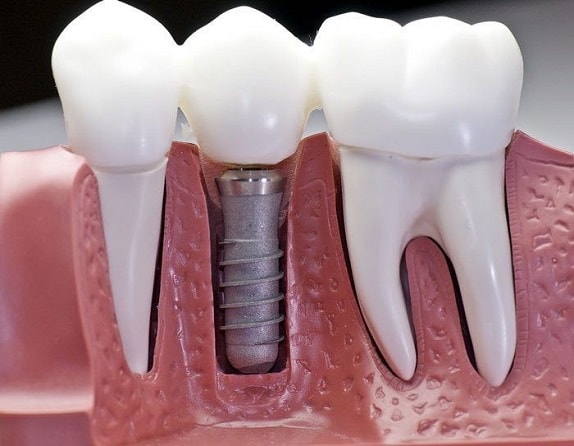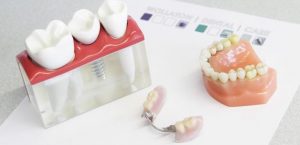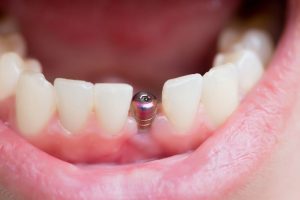A dental implant is a long-term solution for replacing missing teeth. Your dentist places them directly into your jawbone, where they provide an artificial replacement for the root of your missing tooth or teeth. They can support crowns or dentures, in a similar way that roots support natural teeth. Having missing teeth can really knock your confidence, as well as affect the way you eat and speak. Dental implants offer a long-lasting and discreet choice of treatment for replacing teeth.
A dental implant itself is a titanium screw, which is placed directly into your jawbone, replacing your missing tooth root. After it’s fitted, the bone surrounding your implant will gradually fuse to it, holding the implant firmly in place. A false tooth (a crown or denture) is then fitted to the top of the implant (the abutment), giving a natural look to your smile.
You can have a single implant, or you can have multiple ones if you need more than one tooth replaced. It is possible to have several implants fitted in the same procedure. If you have few or no teeth, the smile in a day technique might work for you. This uses four to six implants supported by a bridge. For more information, ask your dentist.
What Do Dental Implants Look Like?
Dental implants are more like natural teeth than dentures. A dental implant looks like a cylinder or screw and it serves as an artificial replacement for the root of a missing tooth. Implants are made of titanium or other material that won’t cause an adverse reaction when they are attached to the jawbone and gum tissue.
Types of Dental Implants
There are three common types of dental implants that you can choose from Endosteal, subperiosteal, and zygomatic. Endosteal is the safest and most common, followed by subperiosteal, and then zygomatic being the last and most complex. It is rarely used.
ENDOSTEAL IMPLANTS
Endosteal implants are the most common type of dental implant. They are suited for most patients but, they require a good, healthy jawbone for the post to fuse to.
They are placeholder posts that are shaped like screws. They put into the jaw that the false teeth are fitted onto.
Once the procedure is done it takes a little time to heal. It requires the time to fuse together and create a stronghold. Once it’s healed the false teeth can be placed onto the post to fit in with the surrounding teeth.
If you don’t like the idea of something being placed into your jawbone, you might like the idea of the second most common implant a little more.
SUBPERIOSTEAL IMPLANTS
Another type of dental implant is Subperiosteal Implants. This is the main alternative to Endosteal Implants.
Instead of being fixed into the jawbone, subperiosteal implants rests on top of the bone but still under the gum.
A metal frame is placed under the gum with a post attached to it. The gum then heals around the frame to hold it in place. The false teeth are secured to the poles that come from the gum.
This procedure is only used if the patient doesn’t have enough jawbone for an implant to be placed or if the person in question just doesn’t want to go through with intensive oral surgery to add bone to the area.
If this applies to you, maybe this next implant will suit you better.
ZYGOMATIC IMPLANTS
Zygomatic implants are the least common type of dental implant available to you. It is the most complicated procedure and should only be done if you don’t have enough jawbone for the Endosteal implant.
The implant is placed in the patient’s cheekbone rather than the jawbone.
Dental implant alternatives
If complications arise and your jaw cannot support implants and a Zygomatic implant is absolutely out of the question, your dentist may suggest other alternatives.
BONE AUGMENTATION
Your dentist will restore the bone in your jaw if, in the case, it cannot support implants. It’s possible to use bone additives to fortify the bone.
SINUS LIFT
This procedure involves adding bone below the sinus if the bone there has managed to deteriorate due to missing upper back teeth.
IMMEDIATE LOAD DENTAL IMPLANTS
This type of dental implant is much like adding a spare tire on to your car except with teeth.
It allows for the temporary placement of a temporary tooth, the same day as your implant placement.
This might be the option for you if you have enough bone and have an implant secure enough to support the placement and pressure of the temporary tooth.
MINI DENTAL IMPLANTS
These are toothpick sized implants that are extremely narrow. Their primary use is to stabilize a lower denture.
They are less innovative than the others, but still a perfectly acceptable option for you to look into.
ALL-ON-4
This is used as an alternative for placing a full set of top or bottom replacement teeth.
Four dental implants are placed in the available bone, this does away with the need of bone grafting. A temporary set of replacement teeth can be placed the same day.
The downside is you will have to follow a special diet while the tissue is still healing and the implants bond with the bone.
After a short 6 months, a permanent set of replacement teeth are placed and you can finally resume your normal diet.
Dental Implants vs. Dentures
The advantages to dental implants vs. dentures include a more natural ability to eat and speak, and there is no need to remove dentures or worry about denture repair. But it is important to see a dentist regularly to be sure your implants are in good condition and to follow a consistent oral care routine of twice-daily tooth brushing and daily flossing.
Benefits of implants
People feel self-conscious if they have missing teeth. With an implant, hopefully you can get your confidence back – whether it’s in your smile, how you eat or when you talk.
One of the reasons people choose implants is that they’re a more permanent option than dentures. So long as you care for your implant properly, they can last as long as natural teeth. Dentures tend to last for around five to 10 years. And as they’re made to fit your mouth exactly, they can become less comfortable as your mouth changes shape over time.
Implants may also be a preferred option if you want to avoid causing any damage to your existing teeth. This can happen if you have a bridge, as sometimes it can mean cutting your natural teeth to fit them.
How will my dental implant be fitted?
Dental implants are usually fitted during two separate procedures; the first being to fit the implant itself into your jawbone, and then the second a few months later to fit the new tooth onto the implant.
You’ll usually be able to have the procedure in your dentist’s surgery, under local anaesthesia. Tell your dentist if you’re feeling particularly anxious about treatment, as they might be able to offer you a sedative to help you relax.
How much do dental implants cost?
The cost of treatment will vary, depending on how many implants you’re having and the complexity of the treatment. Your dentist will be able to give you a good indication of the cost once you’ve discussed your individual treatment plan.
Don’t forget, implants are a long-term solution, so although they tend to cost more than other options for replacing teeth, the benefits are likely to last a lot longer.
Dental implants step-by-step
Whether you are getting one implant or a full arch, it will help to familiarize yourself with the procedure so you know what to expect.
STEP 1 – THE CONSULTATION
The starting point for a dental implant procedure is consultation. A CT scan of your mouth will be taken. Your doctor will create a personalized treatment plan tailored to your needs based on the CT scan.
How long does it take to get dental implants? How long do dental implants take to heal? A treatment coordinator will answer all these questions and any other general questions you may have about implants. He or she will also review and explain full cost for your treatment and discuss different ways to pay for or finance the procedure.
STEP 2 – THE PRE-PROCEDURE EXAM
Once you decide that you are ready to move forward with your dental implant procedure, you will meet with your prosthodontist for a prosthodontic exam. This meeting will answer any remaining questions, and will allow the doctor to collect all information needed for the procedure. After completing your exam, you will be ready to schedule the date and time for your procedure.
STEP 3 – THE DENTAL IMPLANT PROCEDURE
The dental implant procedure gives you a new smile in a single day. You will go home with dental implants that feel and look just like real teeth. You are given temporary crowns or bridges supported by the implants while your mouth heals and adjusts to the change. You will experience a period of soreness following the procedure.
STEP 4 – THE POST-PROCEDURE CHECKUPS
A period of healing follows your dental implant procedure. It is recommended that patients stick to foods they can cut with a fork for six to nine months while the dental implants heal. During this period, typically patients return for a series of checkups to monitor the healing process. This checkups are included in the upfront cost presented to you.
STEP 5 – THE PERMANENT TEETH
This is the final step! When your mouth has finished healing, and your new dental implants have stabilized, your dentist will replace your temporary crown or arch with a new permanent prosthesis. At this point, not only will you have a beautiful, natural smile, you will be able to eat whatever foods you like without difficulty.
How Long Does a Dental Implant Procedure Take?
Keep in mind that the surgery to place dental implants takes several hours, and more than one procedure may be needed. So anyone who is at increased risk for infection may not want to choose dental implants.
If you’re healthy and you undergo surgery for dental implants, be sure to follow your dentist’s instructions for oral hygiene – including twice-daily tooth brushing and daily flossing – following the procedure to keep your new teeth clean and healthy.
HOW TO LOOK AFTER YOUR DENTAL IMPLANTS
WHAT SHOULD I AVOID AFTER MY IMPLANT TREATMENT?
Take care to only have cold drinks and do not eat until the local anaesthetic has worn off. Avoid hot drinks or hot food for the first day and do not ‘swill’ liquid over the area. Try not to disturb the area with your tongue or fingers. Do not undertake strenuous exercise (eg running / gym) for the first 48 hours.
WILL THERE BE SWELLING OR BRUISING AROUND THE IMPLANT?
You may have some swelling and/or bruising following your treatment – this usually reaches a peak two to three days later. This is quite normal and both will subside naturally after a few days. Swelling can be reduced with ice packs (or a bag of frozen peas) wrapped in a towel. Hold on the cheek area for a maximum of ten minutes at a time with twenty minutes’ break. After twenty-four hours, gentle heat is more beneficial. Sleeping propped up slightly on two to three pillows may also help.
WILL THERE BE PAIN AFTER THE IMPLANT PROCEDURE?
Pain should not be a big problem. Although you may be sore for a few days after any surgery in your mouth, this can be easily managed with simple analgesics (painkillers). You should take these regularly at the maximum stated dose for the first two days after your surgery. Take whatever painkillers you normally take for headaches, aches, and sprains (ibuprofen and paracetamol make a good combination), and take your first dose before the local anaesthetic has completely worn off.
CAN I WEAR MY DENTURE AFTER TREATMENT?
If you have a denture that covers the surgical area, please wear it as little as possible for the first week to protect the surgical site during its initial healing period. You should always leave the denture out at night.
WHAT ABOUT THE STITCHES AROUND THE IMPLANT?
The stitches are dissolvable but often remain for around two to three weeks. If they are uncomfortable or annoying, you may contact your dentist to remove them.
Some minor bleeding after surgery in the mouth is perfectly normal. If this persists, apply pressure by biting firmly down over the area on a dampened gauze swab or clean handkerchief for sixty minutes whilst sitting upright. Do not keep checking or changing the gauze. You should contact tour doctor if bleeding persists for any reason after applying pressure in this way.
If you have been given a course of antibiotics to take after your surgery, please ensure that you complete the course.
SHOULD I GET DENTAL IMPLANTS?
But implants aren’t a good choice for everyone. Pregnant women and people with chronic illness or immunosuppression (due to the increased risk of infection during surgery), children (because their jawbones are still developing) and people who grind or clench their teeth (this habit can put too much pressure on implants) are not good candidates for dental implants.







